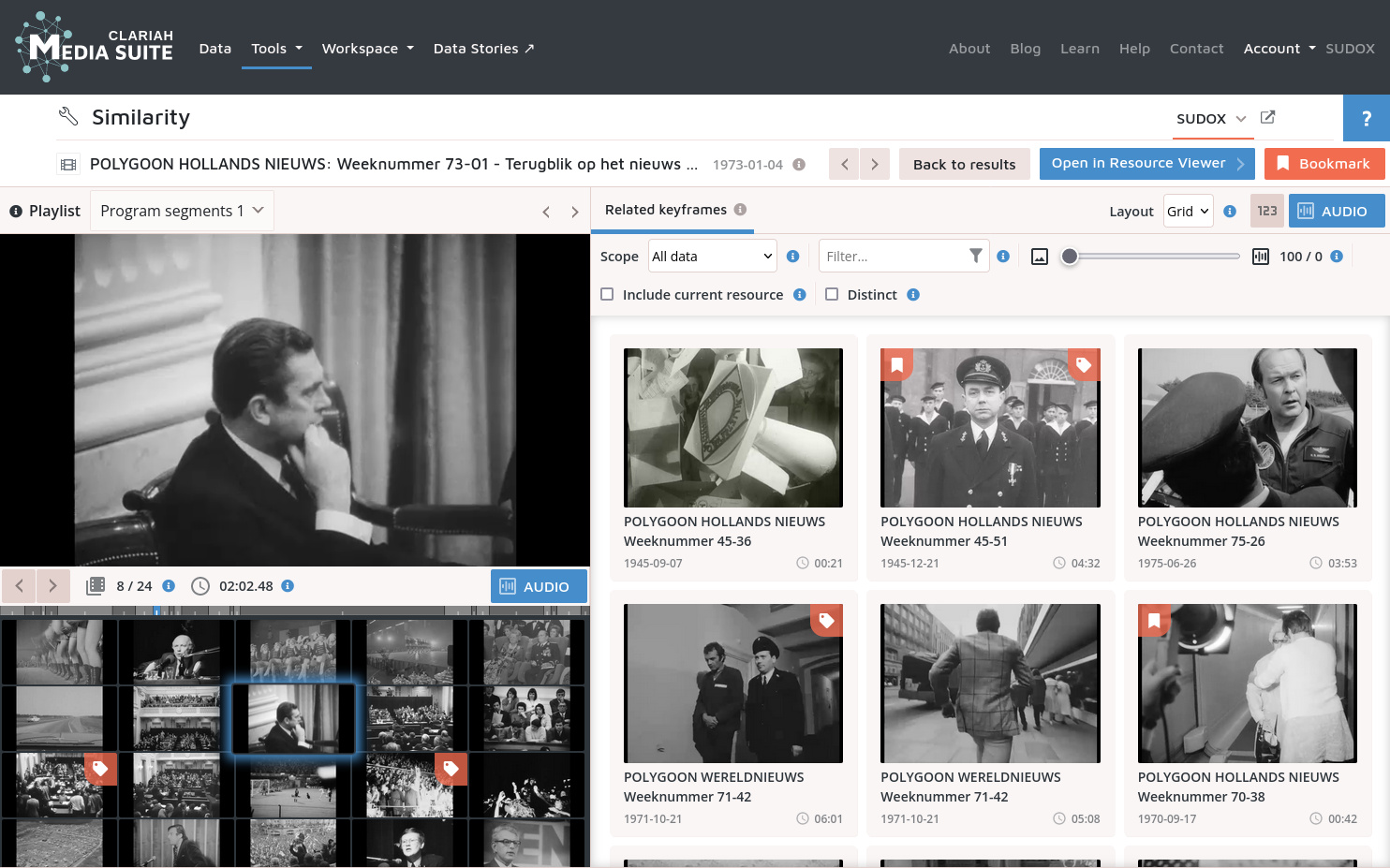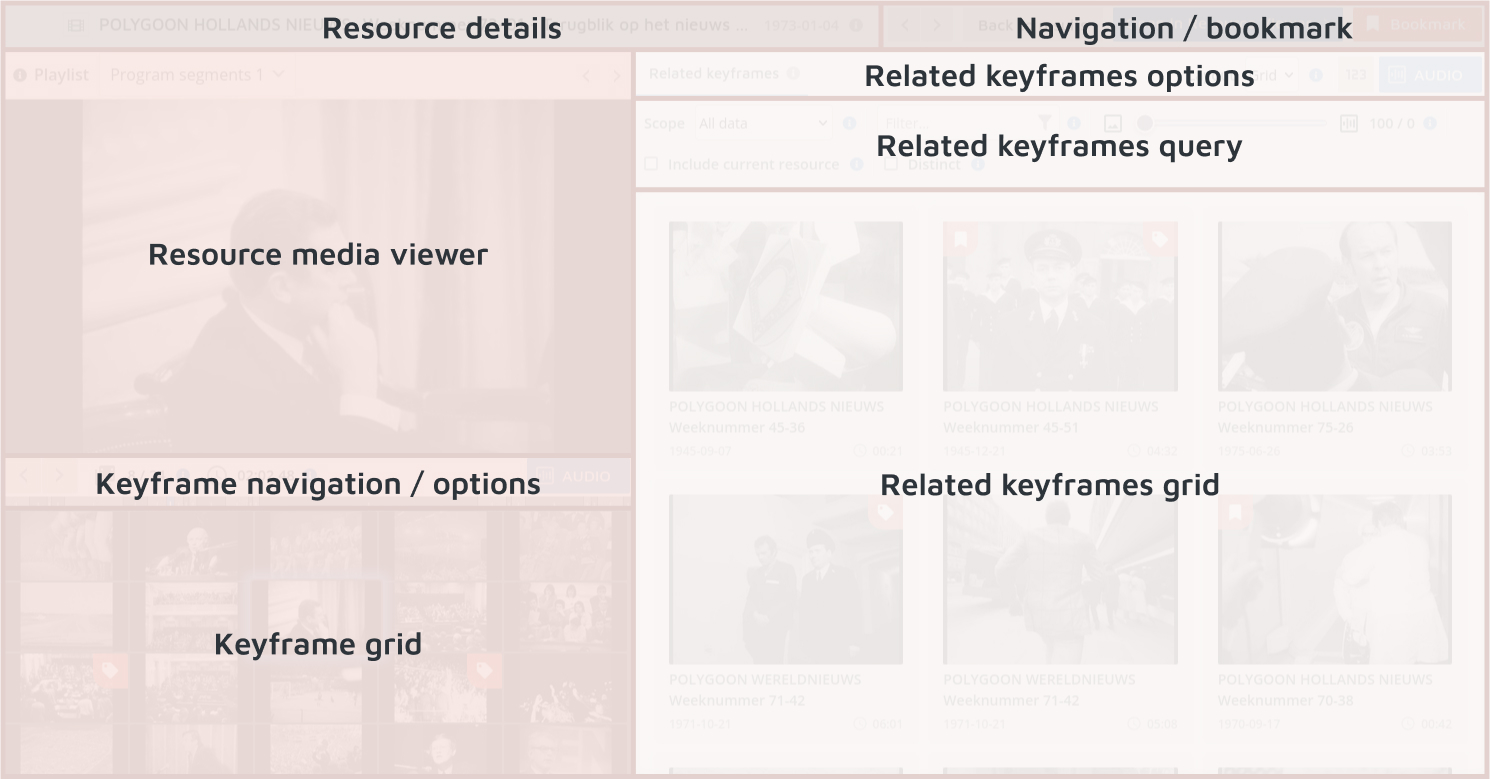This is the “Similarity” tool. In this brief help page you will:
Learn more about this tool’s features
Learn more about this tool’s data
Learn more about the underlying VisXP technology
Intro
The Similarity tool allows you to discover related keyframes from other media resources. Like in the resource viewer, you can watch a media resource, explore and navigate the content using visual keyframes. In addition, related keyframes are retrieved and shown for every keyframe in the resource.
The tool enables researchers to browse a part of the archive in a way that is complementary to the structured search offered in the Search tool. This may expose relationships that are not apparent from the metadata, emerging from the visual domain. These relations are often more associative (like a resemblance in composition or colours) than semantic (like picturing the same object or person).
Note that the current version of the tool is merely a proof of concept, based on a limited amount of data . It is being developed further in 2024, and a bigger part of the collection will be covered.

Features
The Similarity tool offers the following features and functionality.

Current resource keyframes
Keyframes for the resource were selected using the scene detect library .
The keyframes are shown in a grid under the media viewer. They provide a visual overview of the current video. When the video is playing, the currently active keyframe is highlighted. Clicking on a tile moves the player video position to the keyframe timestamp. This way one can navigate the video, in addition to the left/right buttons that move playback to the previous or next keyframe.
The keyframes grid is also available in the resource viewer. It provides the same control for the media playback as in the similarity tool.
Related keyframes
Related keyframes are loaded for the active keyframe. Results can be controlled using the options available in the taskbar above the related keyframes. Consult the info icon behind each option to learn more about its use.
Based on the active keyframe in the left panel, similar keyframes are retrieved by comparing the distance between visual feature vectors that have been created using the VisXP model . Search scores can be displayed by using the score button:

Annotation and bookmarking
Using the annotation button, annotations can be made on a segment that spans the start and end time of the detected shot that the keyframe belongs to. This applies to both the current resource’s keyframes and the related keyframes

Annotations you make will show up in the Resource Viewer, which you can conveniently open by using the resource viewer button on the top right.
Annotations are always added to a new layer called ‘Similarity’. Feel free to edit the contents in the resource viewer. However, keep in mind that: 1) the Similarity tool will always create a new layer called Similarity if not present, and 2) if you change the start/end time of segments, the similarity tool can’t use them for annotations anymore.
In addition, both the current resource and the resources belonging to the related keyframes can be bookmarked to your project.
Data
Currently, only a small selection of the NISV collection has been processed. It contains resources about specific events, for example 9/11 attacks, refugees debate in 2015, and the Dutch ice skating tour called Elfstedentocht.
More data will be added in the future.
VisXP Technology
In VisXP , self-supervised learning was applied to train models for cross-modal audio-video clustering. The models were developed by the Multimedia Analytics group at the University of Amsterdam. To learn more about the training phase, please consult the model documentation with references to the relevant publications.
The trained model allows us to embed all video snippets (shots, in our case) in latent, high-dimensional space. Proximity in this space corresponds to a sense of relatedness or similarity.
The following steps were taken to apply the model to videos in the NISV archive:
-
First, videos were segmented into shots using scenedetect . For every shot, a representative keyframe (image) is extracted.
-
Next, the model (a convolutional neural network) was applied to extract visual features.
-
For similarity search, the nearest items in feature space are retrieved. The vector search itself is handled by an Elastic Search backend.